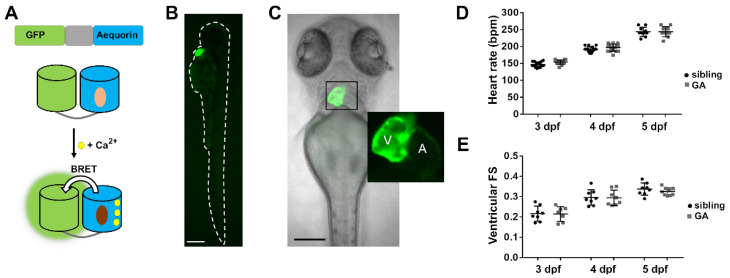Figure 1 Expression of GA in the heart of zebrafish larvae. (A) DNA construct of the chimera GA and scheme of Ca2+-dependent bioluminescence. BRET, bioluminescence resonance energy transfer. Light and dark brown ovals represent CTZ and its excited state product. (B) GFP fluorescence of a 3 dpf Tg(myl7:GA) zebrafish larva. (C) Superimposed GFP fluorescence and transmitted light images of a 3 dpf Tg(myl7:GA) zebrafish larva. The inset shows the atrium (A) and ventricle (V). (D) HR of GA heterozygous and wild-type siblings at 3, 4, and 5 dpf. Data are shown as mean ± SD (n = 17 for 3 and 4 dpf; n = 10 for 5 dpf). (E) Ventricular fractional shortening (FS), measured with the major diameter, of GA heterozygous and sibling larvae at 3, 4, and 5 dpf. Data are shown as mean ± SD (sibling n = 8 for 3, 4, and 5 dpf; GA n = 7 for 3, n = 8 for 4 dpf and n = 9 for 5 dpf). Statistical analysis was performed using an unpaired t-test in (D) and (E) and no statistical differences were found between GA-expressing and sibling larvae (p > 0.05). The bar scale in (B) and (C) indicates 250 µm and 150 µm, respectively.
Image
Figure Caption
Acknowledgments
This image is the copyrighted work of the attributed author or publisher, and
ZFIN has permission only to display this image to its users.
Additional permissions should be obtained from the applicable author or publisher of the image.
Full text @ Biomedicines

